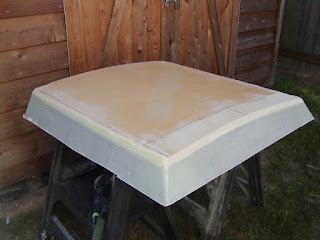I've decided to move ahead with the cockpit compartment plan in my last post. Here's one of the new bulkheads in place:

You can also see where I drew a line around the bottom edge of the cockpit seat, so I'd have a guideline for constructing pre-formed tapes if necessary - which it will be for the two aftmost compartments, unfortunately.
Safety compartment bulkhead set in place, along with both hatch holes cut:
 Cutting the exterior hatch hole in the picture above made me a bit nervous, but I think it will look okay:
Cutting the exterior hatch hole in the picture above made me a bit nervous, but I think it will look okay:
 I moved the placement of the safety compartment from port (where it was in my plan, last post) to starboard after very careful consideration. Namely: I'll normally be towing the boat in the right-hand lane most of the time, and with the safety compartment on the starboard side passing drivers won't be able to see it. :)
I moved the placement of the safety compartment from port (where it was in my plan, last post) to starboard after very careful consideration. Namely: I'll normally be towing the boat in the right-hand lane most of the time, and with the safety compartment on the starboard side passing drivers won't be able to see it. :)
Here I'm working out the placement of the hatch for the semi-dry compartment, and the access hole for the wet compartment:

One of the hatches set in place:

And voila, all the holes are cut:
 There's no real guidance in the plans for how far away from the beam bulkhead any access holes should be. (Yes there is a warning about drain holes, but I don't think that's the same as an access hole). So I just used my best judgement, helped along by reassurance by some pictures of other boats with a similar arrangement.
There's no real guidance in the plans for how far away from the beam bulkhead any access holes should be. (Yes there is a warning about drain holes, but I don't think that's the same as an access hole). So I just used my best judgement, helped along by reassurance by some pictures of other boats with a similar arrangement.
As mentioned, several of my cockpit compartments require pre-forming of tape flanges. I hate having to make these, and I bet I'm not the only one: they just never look as good as tape that was laminated in-place. So I tried to be creative and come up with a way to make a flange that wouldn't end up looking like a dog's breakfast:
 It's just a short piece of pine, with the top edges rounded-over, and a couple of screwing flange supports attached. The supports don't extend all the way to the front so I have room to smooth the tape out against the hull side. I'm not sure it was worth even this little effort, but it didn't turn out too bad:
It's just a short piece of pine, with the top edges rounded-over, and a couple of screwing flange supports attached. The supports don't extend all the way to the front so I have room to smooth the tape out against the hull side. I'm not sure it was worth even this little effort, but it didn't turn out too bad:

See that white stripe thing extending across the top of the flange\tape? I didn't cover that portion of the mold with masking tape - duh. Such an idiot. Good thing I removed the mold while the tape was still green, or it would have been a real mess.
One more picture of my flange-making efforts:
 I won't do pre-made flanges for the compartments that are open to the cabin interior, but I've decided to do complete flanges for all the other compartments. I just don't see how I could do a very good job of taping while working through the two access holes, even if the boat was inverted.
I won't do pre-made flanges for the compartments that are open to the cabin interior, but I've decided to do complete flanges for all the other compartments. I just don't see how I could do a very good job of taping while working through the two access holes, even if the boat was inverted.
I'm getting excited about glueing on the cockpit seats, but I have almost decided to first do some (rough) fairing, priming, and painting of these compartments while I still have good access to them. It will be just impossible to do any quality work on them later through the access holes.
 And:
And: Clearly it will need some trimming (both to level it out, and to shorten the sides) but I'm feeling better that it doesn't look too lopsided or otherwise unsalvageable. I plan to clamp some temporary wood supports to the hatch coamings on the boat to hold the hatch up, then scribe a trim line so the hatch fits reasonably close to the deck.
Clearly it will need some trimming (both to level it out, and to shorten the sides) but I'm feeling better that it doesn't look too lopsided or otherwise unsalvageable. I plan to clamp some temporary wood supports to the hatch coamings on the boat to hold the hatch up, then scribe a trim line so the hatch fits reasonably close to the deck.








































